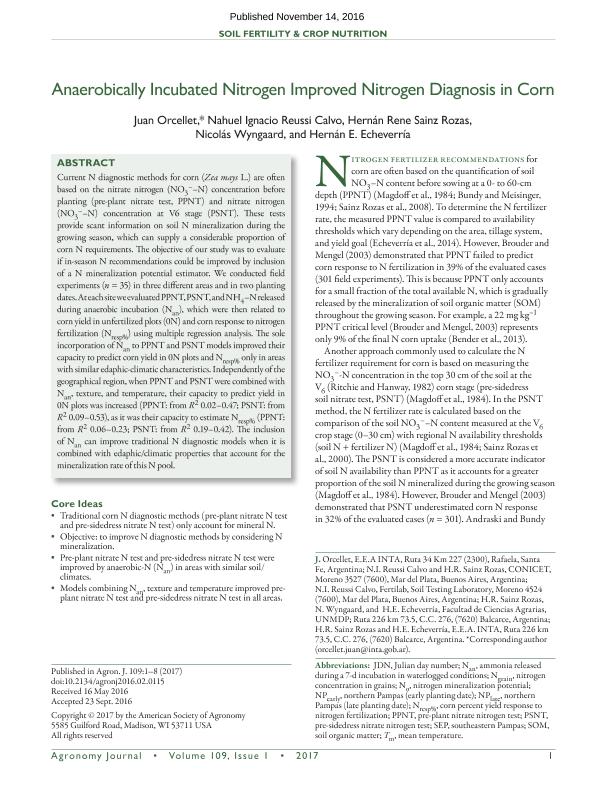Mostrar el registro sencillo del ítem
dc.contributor.author
Orcellet, Juan
dc.contributor.author
Reussi Calvo, Nahuel Ignacio

dc.contributor.author
Sainz Rozas, Hernan Rene

dc.contributor.author
Wyngaard, Nicolás

dc.contributor.author
Echeverria, Hernan Eduardo

dc.date.available
2019-07-19T18:45:54Z
dc.date.issued
2017-01
dc.identifier.citation
Orcellet, Juan; Reussi Calvo, Nahuel Ignacio; Sainz Rozas, Hernan Rene; Wyngaard, Nicolás; Echeverria, Hernan Eduardo; Anaerobically incubated nitrogen improved nitrogen diagnosis in corn; American Society of Agronomy; Agronomy Journal; 109; I; 1-2017; 291-298
dc.identifier.issn
0002-1962
dc.identifier.uri
http://hdl.handle.net/11336/79919
dc.description.abstract
Current N diagnostic methods for corn (Zea mays L.) are often based on the nitrate nitrogen (NO3––N) concentration before planting (pre-plant nitrate test, PPNT) and nitrate nitrogen (NO3––N) concentration at V6 stage (PSNT). These tests provide scant information on soil N mineralization during the growing season, which can supply a considerable proportion of corn N requirements. The objective of our study was to evaluate if in-season N recommendations could be improved by inclusion of a N mineralization potential estimator. We conducted field experiments (n = 35) in three different areas and in two planting dates. At each site we evaluated PPNT, PSNT, and NH4–N released during anaerobic incubation (Nan), which were then related to corn yield in unfertilized plots (0N) and corn response to nitrogen fertilization (Nresp%) using multiple regression analysis. The sole incorporation of Nan to PPNT and PSNT models improved their capacity to predict corn yield in 0N plots and Nresp% only in areas with similar edaphic-climatic characteristics. Independently of the geographical region, when PPNT and PSNT were combined with Nan, texture, and temperature, their capacity to predict yield in 0N plots was increased (PPNT: from R2 0.02–0.47; PSNT: from R2 0.09–0.53), as it was their capacity to estimate Nresp% (PPNT: from R2 0.06–0.23; PSNT: from R2 0.19–0.42). The inclusion of Nan can improve traditional N diagnostic models when it is combined with edaphic/climatic properties that account for the mineralization rate of this N pool.
dc.format
application/pdf
dc.language.iso
eng
dc.publisher
American Society of Agronomy

dc.rights
info:eu-repo/semantics/openAccess
dc.rights.uri
https://creativecommons.org/licenses/by-nc-sa/2.5/ar/
dc.subject
Nitrogen
dc.subject
Corn
dc.subject
Incubation
dc.subject.classification
Agricultura

dc.subject.classification
Agricultura, Silvicultura y Pesca

dc.subject.classification
CIENCIAS AGRÍCOLAS

dc.title
Anaerobically incubated nitrogen improved nitrogen diagnosis in corn
dc.type
info:eu-repo/semantics/article
dc.type
info:ar-repo/semantics/artículo
dc.type
info:eu-repo/semantics/publishedVersion
dc.date.updated
2019-06-10T21:49:06Z
dc.journal.volume
109
dc.journal.number
I
dc.journal.pagination
291-298
dc.journal.pais
Estados Unidos

dc.description.fil
Fil: Orcellet, Juan. Instituto Nacional de Tecnología Agropecuaria; Argentina. Consejo Nacional de Investigaciones Científicas y Técnicas. Centro Científico Tecnológico Conicet - Mar del Plata; Argentina
dc.description.fil
Fil: Reussi Calvo, Nahuel Ignacio. Laboratorio de Analisis de Suelos Fertilab; Argentina. Consejo Nacional de Investigaciones Científicas y Técnicas. Centro Científico Tecnológico Conicet - Mar del Plata; Argentina
dc.description.fil
Fil: Sainz Rozas, Hernan Rene. Instituto Nacional de Tecnología Agropecuaria; Argentina
dc.description.fil
Fil: Wyngaard, Nicolás. Universidad Nacional de Mar del Plata. Facultad de Ciencias Agrarias; Argentina
dc.description.fil
Fil: Echeverria, Hernan Eduardo. Instituto Nacional de Tecnología Agropecuaria; Argentina
dc.journal.title
Agronomy Journal

dc.relation.alternativeid
info:eu-repo/semantics/altIdentifier/doi/http://dx.doi.org/10.2134/agronj2016.02.0115
dc.relation.alternativeid
info:eu-repo/semantics/altIdentifier/url/https://dl.sciencesocieties.org/publications/aj/abstracts/109/1/291
Archivos asociados
